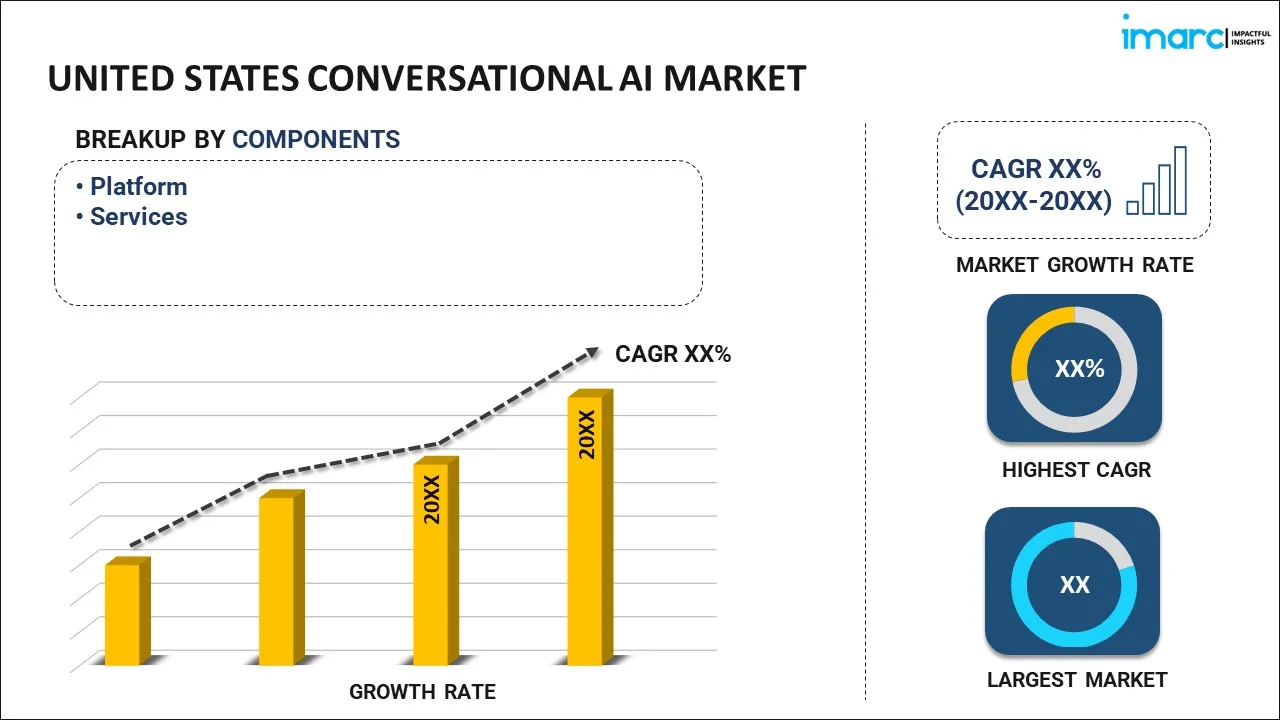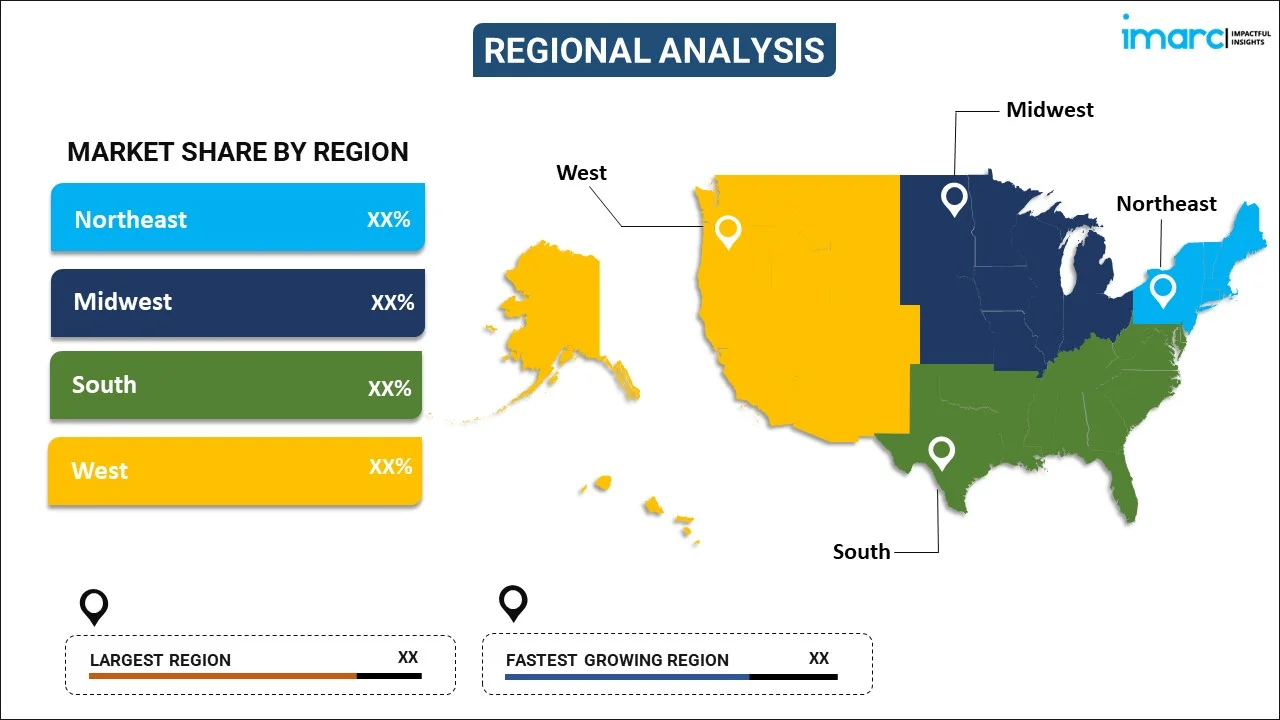
United States Conversational AI Market Report by Component (Platform, Services), Type (Intelligent Virtual Assistant (IVA), Chatbots), Technology (Machine Learning, Deep Learning, Natural Language Processing, Automatic Speech Recognition), Deployment Mode (Cloud-based, On-premises), Organization Size (Large Enterprises, Small and Medium-sized Enterprises), End User (BFSI, Retail and E-commerce, Healthcare and Life Science, Travel and Hospitality, Telecom, Media and Entertainment, and Others), and Region 2025-2033
Market Overview:
United States conversational AI market size is projected to exhibit a growth rate (CAGR) of 25.27% during 2025-2033. The increasing popularity of messaging apps and platforms, which has led businesses to integrate conversational AI into these channels, is driving the market.
|
Report Attribute
|
Key Statistics
|
|---|---|
|
Base Year
|
2024 |
|
Forecast Years
|
2025-2033 |
|
Historical Years
|
2019-2024
|
| Market Growth Rate (2025-2033) | 25.27% |
Conversational AI refers to the use of artificial intelligence technologies to enable natural, human-like interactions between computers and users. It encompasses various techniques such as natural language processing, machine learning, and chatbot technologies to understand, interpret, and respond to human language in a way that simulates a conversation. This technology enables systems to comprehend user inputs, recognize intent, and generate appropriate responses, fostering seamless communication. Conversational AI finds applications in chatbots, virtual assistants, and voice-activated systems, enhancing user experiences in customer support, information retrieval, and task automation. The goal is to create intuitive and efficient interfaces that enable users to interact with technology in a manner that mirrors human conversation, ultimately improving accessibility and usability across a wide range of applications and industries.
United States Conversational AI Market Trends:
The conversational AI market in the United States is experiencing robust growth, driven by several key factors. Firstly, the increasing demand for personalized and seamless customer experiences propels the adoption of conversational AI solutions across industries. Moreover, businesses are recognizing the efficiency gains and cost savings achieved through automation, fostering a surge in conversational AI implementation. Additionally, advancements in natural language processing (NLP) and machine learning technologies play a pivotal role in enhancing the capabilities of conversational AI, making interactions more human-like and contextually aware. Furthermore, the proliferation of digital channels, including messaging apps and voice-activated devices, fuels the need for conversational interfaces. This shift in consumer behavior towards more conversational and convenient interactions accelerates the market's momentum. Simultaneously, the rising importance of virtual communication prompts organizations to invest in AI-driven conversational tools for remote collaboration and customer support. In conclusion, the regional conversational AI market is thriving due to a convergence of factors, encompassing the pursuit of enhanced customer experiences, automation efficiencies, technological advancements, changing consumer preferences, and the imperative for remote communication in today's dynamic business landscape.
United States Conversational AI Market Segmentation:
IMARC Group provides an analysis of the key trends in each segment of the market, along with forecasts at the country level for 2025-2033. Our report has categorized the market based on component, type, technology, deployment mode, organization size, and end user.
Component Insights:

- Platform
- Services
- Support and Maintenance
- Training and Consulting
- System Integration
The report has provided a detailed breakup and analysis of the market based on the component. This includes platform and services (support and maintenance, training and consulting, and system integration).
Type Insights:
- Intelligent Virtual Assistant (IVA)
- Chatbots
A detailed breakup and analysis of the market based on the type have also been provided in the report. This includes intelligent virtual assistant (IVA) and chatbots.
Technology Insights:
- Machine Learning
- Deep Learning
- Natural Language Processing
- Automatic Speech Recognition
The report has provided a detailed breakup and analysis of the market based on the technology. This includes machine learning, deep learning, natural language processing, and automatic speech recognition.
Deployment Mode Insights:
- Cloud-based
- On-premises
A detailed breakup and analysis of the market based on the deployment mode have also been provided in the report. This includes cloud-based and on-premises.
Organization Size Insights:
- Large Enterprises
- Small and Medium-sized Enterprises
The report has provided a detailed breakup and analysis of the market based on the organization size. This includes large enterprises and small and medium-sized enterprises.
End User Insights:
- BFSI
- Retail and E-commerce
- Healthcare and Life Science
- Travel and Hospitality
- Telecom
- Media and Entertainment
- Others
A detailed breakup and analysis of the market based on the end user have also been provided in the report. This includes BFSI, retail and E-commerce, healthcare and life science, travel and hospitality, telecom, media and entertainment, and others.
Regional Insights:

- Northeast
- Midwest
- South
- West
The report has also provided a comprehensive analysis of all the major regional markets, which include Northeast, Midwest, South, and West.
Competitive Landscape:
The market research report has also provided a comprehensive analysis of the competitive landscape. Competitive analysis such as market structure, key player positioning, top winning strategies, competitive dashboard, and company evaluation quadrant has been covered in the report. Also, detailed profiles of all major companies have been provided.
United States Conversational AI Market Report Coverage:
| Report Features | Details |
|---|---|
| Base Year of the Analysis | 2024 |
| Historical Period | 2019-2024 |
| Forecast Period | 2025-2033 |
| Units | Billion USD |
| Scope of the Report | Exploration of Historical and Forecast Trends, Industry Catalysts and Challenges, Segment-Wise Historical and Predictive Market Assessment:
|
| Components Covered |
|
| Types Covered | Intelligent Virtual Assistant (IVA), Chatbots |
| Technologies Covered | Machine Learning, Deep Learning, Natural Language Processing, Automatic Speech Recognition |
| Deployment Modes Covered | Cloud-based, On-premises |
| Organization Sizes Covered | Large Enterprises, Small and Medium-sized Enterprises |
| End Users Covered | BFSI, Retail and E-commerce, Healthcare and Life Science, Travel and Hospitality, Telecom, Media and Entertainment, Others |
| Regions Covered | Northeast, Midwest, South, West |
| Customization Scope | 10% Free Customization |
| Post-Sale Analyst Support | 10-12 Weeks |
| Delivery Format | PDF and Excel through Email (We can also provide the editable version of the report in PPT/Word format on special request) |
Key Questions Answered in This Report:
- How has the United States conversational AI market performed so far and how will it perform in the coming years?
- What has been the impact of COVID-19 on the United States conversational AI market?
- What is the breakup of the United States conversational AI market on the basis of component?
- What is the breakup of the United States conversational AI market on the basis of type?
- What is the breakup of the United States conversational AI market on the basis of technology?
- What is the breakup of the United States conversational AI market on the basis of deployment mode?
- What is the breakup of the United States conversational AI market on the basis of organization size?
- What is the breakup of the United States conversational AI market on the basis of end user?
- What are the various stages in the value chain of the United States conversational AI market?
- What are the key driving factors and challenges in the United States conversational AI?
- What is the structure of the United States conversational AI market and who are the key players?
- What is the degree of competition in the United States conversational AI market?
Key Benefits for Stakeholders:
- IMARC’s industry report offers a comprehensive quantitative analysis of various market segments, historical and current market trends, market forecasts, and dynamics of the United States conversational AI market from 2019-2033.
- The research report provides the latest information on the market drivers, challenges, and opportunities in the United States conversational AI market.
- Porter's five forces analysis assist stakeholders in assessing the impact of new entrants, competitive rivalry, supplier power, buyer power, and the threat of substitution. It helps stakeholders to analyze the level of competition within the United States conversational AI industry and its attractiveness.
- Competitive landscape allows stakeholders to understand their competitive environment and provides an insight into the current positions of key players in the market.
Need more help?
- Speak to our experienced analysts for insights on the current market scenarios.
- Include additional segments and countries to customize the report as per your requirement.
- Gain an unparalleled competitive advantage in your domain by understanding how to utilize the report and positively impacting your operations and revenue.
- For further assistance, please connect with our analysts.

 Inquire Before Buying
Inquire Before Buying
 Speak to an Analyst
Speak to an Analyst
 Request Brochure
Request Brochure
 Request Customization
Request Customization



.webp)




.webp)












